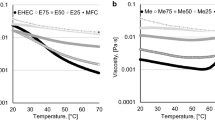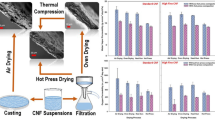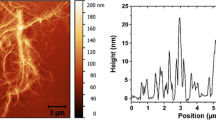Abstract
The preparation of carboxymethylated microfibrillated cellulose (MFC) films by dispersion-casting from aqueous dispersions and by surface coating on base papers is described. The oxygen permeability of MFC films were studied at different relative humidity (RH). At low RH (0%), the MFC films showed very low oxygen permeability as compared with films prepared from plasticized starch, whey protein and arabinoxylan and values in the same range as that of conventional synthetic films, e.g., ethylene vinyl alcohol. At higher RH’s, the oxygen permeability increased exponentially, presumably due to the plasticizing and swelling of the carboxymethylated nanofibers by water molecules. The effect of moisture on the barrier and mechanical properties of the films was further studied using water vapor sorption isotherms and by humidity scans in dynamic mechanical analysis. The influences of the degree of nanofibrillation/dispersion on the microstructure and optical properties of the films were evaluated by field-emission scanning electron microscopy (FE-SEM) and light transmittance measurements, respectively. FE-SEM micrographs showed that the MFC films consisted of randomly assembled nanofibers with a thickness of 5–10 nm, although some larger aggregates were also formed. The use of MFC as surface coating on various base papers considerably reduced the air permeability. Environmental scanning electron microscopy (E-SEM) micrographs indicated that the MFC layer reduced sheet porosity, i.e., the dense structure formed by the nanofibers resulted in superior oil barrier properties.











Similar content being viewed by others
References
Arvanitoyannis IS (2006) Handbook of biodegradable polymeric materials and their applications. American Scientific Publishers, US
Arvanitoyannis I, Psomiadou E, Nakayama A, Aiba S, Yamamoto N (1997) Edible films made from gelatin, soluble starch and polyols, part 3. Food Chem 60:593–604
Arvanitoyannis I, Nakayama A, Aiba S-I (1998) Edible films made from hydroxypropyl starch and gelatin and plasticized by polyols and water. Carbohydr Polym 36:105–119
Asthana SK, Koteswara Rao MVR, Balakrishna KJ (1964) Pinene-free turpentine as a paint thinner. Perfumery Essential Oil Record 55:725–727
Aulin C, Ahola S, Josefsson P, Nishino T, Hirose Y, Österberg M, Wågberg L (2009) Nanoscale cellulose films with different crystallinities and mesostructures-their surface properties and interaction with water. Langmuir 25:7675–7685
Avranitoyannis I, Psomiadou E, Nakayama A (1997) Edible films made from sodium caseinate, starches, sugars or glycerol. Part 1. Carbohydr Polym 31:179–192
Bardage S, Donaldson L, Tokoh C, Daniel G (2004) Ultrastructure of the cell wall of unbeaten Norway spruce pulp fibre surfaces. Nordic Pulp Paper Res J 19:448–452
Bercea M, Navard P (2000) Shear dynamics of aqueous suspensions of cellulose whiskers. Macromolecules 33:6011–6016
Butler BL, Vergano PJ, Testin RF, Bunn JM, Wiles JL (1996) Mechanical and barrier properties of edible chitosan films as affected by composition and storage. J Food Sci 61:953–955, 961
Chanzy H (2009) Personal communication
Chen W, Lickfield GC, Yang CQ (2004) Molecular modeling of cellulose in amorphous state part II: effects of rigid and flexible crosslinks on cellulose. Polymer 45:7357–7365
Cox HL (1952) The elasticity and strength of paper and other fibrous materials. Br J Appl Physics 3:72–79
Deisenroth E, Jho C, Haniff M, Jennings J (1998) The designing of a new grease repellent fluorochemical for the paper industry. Surf Coatings Int 81:440–447
Diddens I, Murphy B, Krisch M, Mueller M (2008) Anisotropic elastic properties of cellulose measured using inelastic X-ray scattering. Macromolecules 41:9755–9759
Dole P, Joly C, Espuche E, Alric I, Gontard N (2004) Gas transport properties of starch based films. Carbohydr Polym 58:335–343
Ebeling T, Paillet M, Borsali R, Diat O, Dufresne A, Cavaille JY, Chanzy H (1999) Shear-induced orientation phenomena in suspensions of cellulose microcrystals, revealed by small angle X-ray scattering. Langmuir 15:6123–6126
Fengel D (1971) Ultrastructural organization of the cell wall components. J Polym Sci, Polym Symposia 36:383–392
Fried JR, Karasz FE, MacKnight WJ (1978) Compatibility of poly(2, 6-dimethyl-1, 4-phenylene oxide) (PPO)/poly(styrene-co-4-chlorostyrene) blends. 1. Differential scanning calorimetry and density studies. Macromolecules 11:150–158
Fukuzumi H, Saito T, Iwata T, Kumamoto Y, Isogai A (2009) Transparent and high gas barrier films of cellulose nanofibers prepared by TEMPO-mediated oxidation. Biomacromolecules 10:162–165
Gontard N, Guilbert S, Cuq JL (1992) Edible wheat gluten films: influence of the main process variables on film properties using response surface methodology. J Food Sci 57:190–195, 199
Gontard N, Thibault R, Cuq B, Guilbert S (1996) Influence of relative humidity and film composition on oxygen and carbon dioxide permeability’s of edible films. J Agric Food Chem 44:1064–1069
Gröndahl M, Eriksson L, Gatenholm P (2004) Material properties of plasticized hardwood xylans for potential application as oxygen barrier films. Biomacromolecules 5:1528–1535
Hansen NML, Plackett D (2008) Sustainable films and coatings from hemicelluloses: a review. Biomacromolecules 9:1493–1505
Hartman J, Albertsson A-C, Lindblad MS, Sjöberg J (2006a) Oxygen barrier materials from renewable sources: material properties of softwood hemicellulose-based films. J Appl Polym Sci 100:2985–2991
Hartman J, Albertsson A-C, Sjöberg J (2006b) Surface- and bulk-modified galactoglucomannan hemicellulose films and film laminates for versatile oxygen barriers. Biomacromolecules 7:1983–1989
Henriksson M, Berglund LA, Isaksson P, Lindström T, Nishino T (2008) Cellulose nanopaper structures of high toughness. Biomacromolecules 9:1579–1585
Herrick FW, Casebier RL, Hamilton JK, Sandberg KR (1983) Microfibrillated cellulose: morphology and accessibility. JAppl Polym Sci: Appl Polym Symp 37:797–813
Höije A, Sternemalm E, Heikkinen S, Tenkanen M, Gatenholm P (2008) Material properties of films from enzymatically tailored arabinoxylans. Biomacromolecules 9:2042–2047
Ito K, Saito Y, Yamamoto T, Ujihira Y, Nomura K (2001) Correlation study between oxygen permeability and free volume of ethylene-vinyl alcohol copolymer through positronium lifetime measurement. Macromolecules 34:6153–6155
Jeronimidis G, Vincent JFV (1984) Composite materials. Topics Mol Struct Biol 5:187–210
Kendall K (2001) Molecular adhesion and its applications: the sticky universe. Kluwer Academic/Plenum Publishers, New York
Kissa E (2001) Fluorinated surfactants and repellents, revised and expanded. Marcel Dekker, New York
Kjellgren H, Engström G (2006) Influence of base paper on the barrier properties of chitosan-coated papers. Nordic Pulp Paper Res J 21:685–689
Kjellgren H, Gällstedt M, Engström G, Järnström L (2006) Barrier and surface properties of chitosan-coated greaseproof paper. Carbohydr Polym 65:453–460
Kohler R, Alex R, Brielmann R, Ausperger B (2006) A new kinetic model for water sorption isotherms of cellulosic materials. Macromol Symp 244:89–96
Krochta JM (2007) Food packaging. Marcel Dekker Inc, New York
Labuschagne PW, Germishuizen WA, Verryn SMC, Moolman FS (2008) Improved oxygen barrier performance of poly(vinyl alcohol) films through hydrogen bond complex with poly(methyl vinyl ether-co-maleic acid). Eur Polym J 44:2146–2152
Lange J, Wyser Y (2003) Recent innovations in barrier technologies for plastic packaging—a review. Packaging Technol Sci 16:149–158
McGonigle EA, Liggat JJ, Pethrick RA, Jenkins SD, Daly JH, Hayward D (2000) Permeability of N2, Ar, He, O2 and CO2 through biaxially oriented polyester films—dependence on free volume. Polymer 42:2413–2426
McHugh TH, Krochta JM (1994a) Edible coatings films improve food quality. Technomic, Lancaster
McHugh TH, Krochta JM (1994b) Permeability properties of edible films. CRC Press, US
McHugh TH, Krochta JM (1994c) Sorbitol- vs glycerol-plasticized whey protein edible films: integrated oxygen permeability and tensile property evaluation. J Agric Food Chem 42:841–845
Miller KS, Krochta JM (1997) Oxygen and aroma barrier properties of edible films: a review. Trends Food Sci Technol 8:228–237
Newton KG, Rigg WJ (1979) The effect of film permeability on the storage life and microbiology of vacuum-packed meat. J Appl Bacteriol 47:433–441
Ono H, Yamada H, Matsuda S, Okajima K, Kawamoto T, Iijima H (1998) Proton-NMR relaxation of water molecules in the aqueous microcrystalline cellulose suspension systems and their viscosity. Cellulose 5:231–247
Orts WJ, Godbout L, Marchessault RH, Revol JF (1998) Enhanced ordering of liquid crystalline suspensions of cellulose microfibrils: a small-angle neutron scattering study. Macromolecules 31:5717–5725
Pääkkö M, Ankerfors M, Kosonen H, Nykänen A, Ahola S, Österberg M, Ruokolainen J, Laine J, Larsson PT, Ikkala O, Lindström T (2007) Enzymatic hydrolysis combined with mechanical shearing and high-pressure homogenization for nanoscale cellulose fibrils and strong gels. Biomacromolecules 8:1934–1941
Pedrosa P, Pomposo JA, Calahorra E, Cortazar M (1994) On the glass transition behavior, interaction energies, and hydrogen-bonding strengths of binary poly(p-vinylphenol)/polyether blends. Macromolecules 27:102–109
Psomiadou E, Arvanitoyannis I, Yamamoto N (1997) Edible films made from natural resources; microcrystalline cellulose (MCC), methylcellulose (MC) and corn starch and polyols. Part 2. Carbohydr Polym 31:193–204
Rindlav-Westling A, Stading M, Hermansson A-M, Gatenholm P (1998) Structure, mechanical and barrier properties of amylose and amylopectin films. Carbohydr Polym 36:217–224
Schwartz C (1981) Oil resistance utilizing fluorochemicals. Technical association of the pulp and paper industry, section sizing, Chicago. Tappi Press, US
Sothornvit R, Krochta JM (2000) Plasticizer effect on oxygen permeability of beta -lactoglobulin films. J Agric Food Chem 48:6298–6302
Svagan AJ, Samir MASA, Berglund LA (2007) Biomimetic polysaccharide nanocomposites of high cellulose content and high toughness. Biomacromolecules 8:2556–2563
Syverud K, Stenius P (2009) Strength and barrier properties of MFC films. Cellulose 16:75–85
Turbak AF, Snyder FW, Sandberg KR (1983) Microfibrillated cellulose, a new cellulose product: properties, uses, and commercial potential. J Appl Polym Sci: Appl Polym Symp 37:815–827
Wågberg L, Winter L, Ödberg L, Lindström T (1987) On the charge stoichiometry upon adsorption of a cationic polyelectrolyte on cellulosic materials. Colloids Surf 27:163–173
Wågberg L, Decher G, Norgren M, Lindström T, Ankerfors M, Axnäs K (2008) The build-up of polyelectrolyte multilayers of microfibrillated cellulose and cationic polyelectrolytes. Langmuir 24:784–795
Winter L, Wågberg L, Ödberg L, Lindström T (1986) Polyelectrolytes adsorbed on the surface of cellulosic materials. J Colloid Interf Sci 111:537–543
Wu J, Yuan Q (2002) Gas permeability of a novel cellulose membrane. J Membr Sci 204:185–194
Yano H, Sugiyama J, Nakagaito AN, Nogi M, Matsuura T, Hikita M, Handa K (2005) Optically transparent composites reinforced with networks of bacterial nanofibers. Adv Mater 17:153–155
Acknowledgments
The authors wish to thank BIM Kemi Sweden AB and the Knowledge Foundation through its graduate school YPK for financial support. Professor Lars Ödberg, Dr. Torbjörn Pettersson and Dr. Henrik Kjellgren are acknowledged for valuable discussions. Joanna Hornatowska is gratefully acknowledged for help with the E-SEM measurements.
Author information
Authors and Affiliations
Corresponding author
Electronic supplementary material
Below is the link to the electronic supplementary material.
Rights and permissions
About this article
Cite this article
Aulin, C., Gällstedt, M. & Lindström, T. Oxygen and oil barrier properties of microfibrillated cellulose films and coatings. Cellulose 17, 559–574 (2010). https://doi.org/10.1007/s10570-009-9393-y
Received:
Accepted:
Published:
Issue Date:
DOI: https://doi.org/10.1007/s10570-009-9393-y




